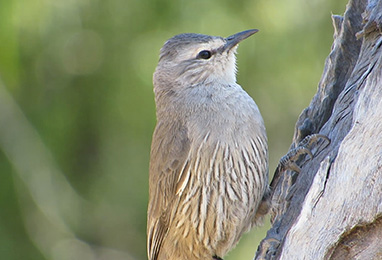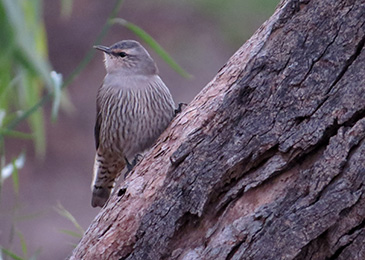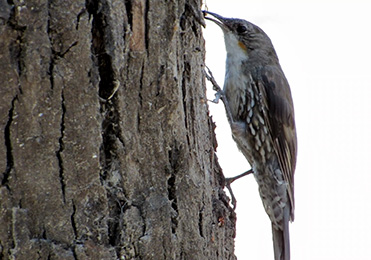TREECREEPERS
Australia’s Treecreepers are the continent’s answer to the woodpeckers found elsewhere, though they belong to a different family altogether, the Climacteridae.
Treecreepers are modest in size, with muted brown and white feathers that provide impeccable camouflage against the bark of trees. This plumage is like nature’s own cloak of invisibility, allowing them to blend seamlessly with their arboreal homes.
As their name suggests, Treecreepers have a peculiar and fascinating way of moving. They ascend tree trunks in a spiraling fashion, using their strong, curved claws to grip the bark and their stiff tail feathers for support. This upward journey is not just for show – it’s a strategic hunt for food. Their sharp, down-curved beaks probe into crevices, seeking out insects and spiders that hide within the bark’s cracks and crevices.
The life of a Treecreeper is one of tireless effort and simplicity. They are solitary creatures, often found alone or in pairs, diligently working their way up the trees before flying down to the base of another to begin their ascent anew. This routine is a dance of survival, one that is repeated day after day.
In the context of their habitat, Treecreepers favor eucalyptus forests, woodlands, and even scrublands across Australia. Their presence is a quiet testament to the health of these ecosystems. Each species of Treecreeper has adapted to its specific environment, with some preferring the wetter forests in the east, while others thrive in the drier woodlands to the west and north.
The nests of Treecreepers are feats of natural engineering. They use their beaks to create hollows in trees or appropriate existing cavities, lining them with soft materials to prepare for their young. The breeding season sees these birds become more vocal, with a variety of calls that fill the air, yet another layer of the rich tapestry of sounds in the Australian bush.
While Treecreepers may not be as flashy or as well-known as some of Australia’s other avian species, they are an integral part of the ecosystem. Their constant search for insects helps to control pest populations, and their nesting habits contribute to the biodiversity of their habitats.
Conservation efforts for Treecreepers, as with all wildlife, are crucial. Protecting their natural habitats from deforestation and degradation ensures that these unique birds can continue their arboreal acrobatics for generations to come. By understanding and appreciating the role of Treecreepers in the ecosystem, we can foster a desire to preserve the natural wonders of Australia, including the quiet yet captivating Treecreepers.



